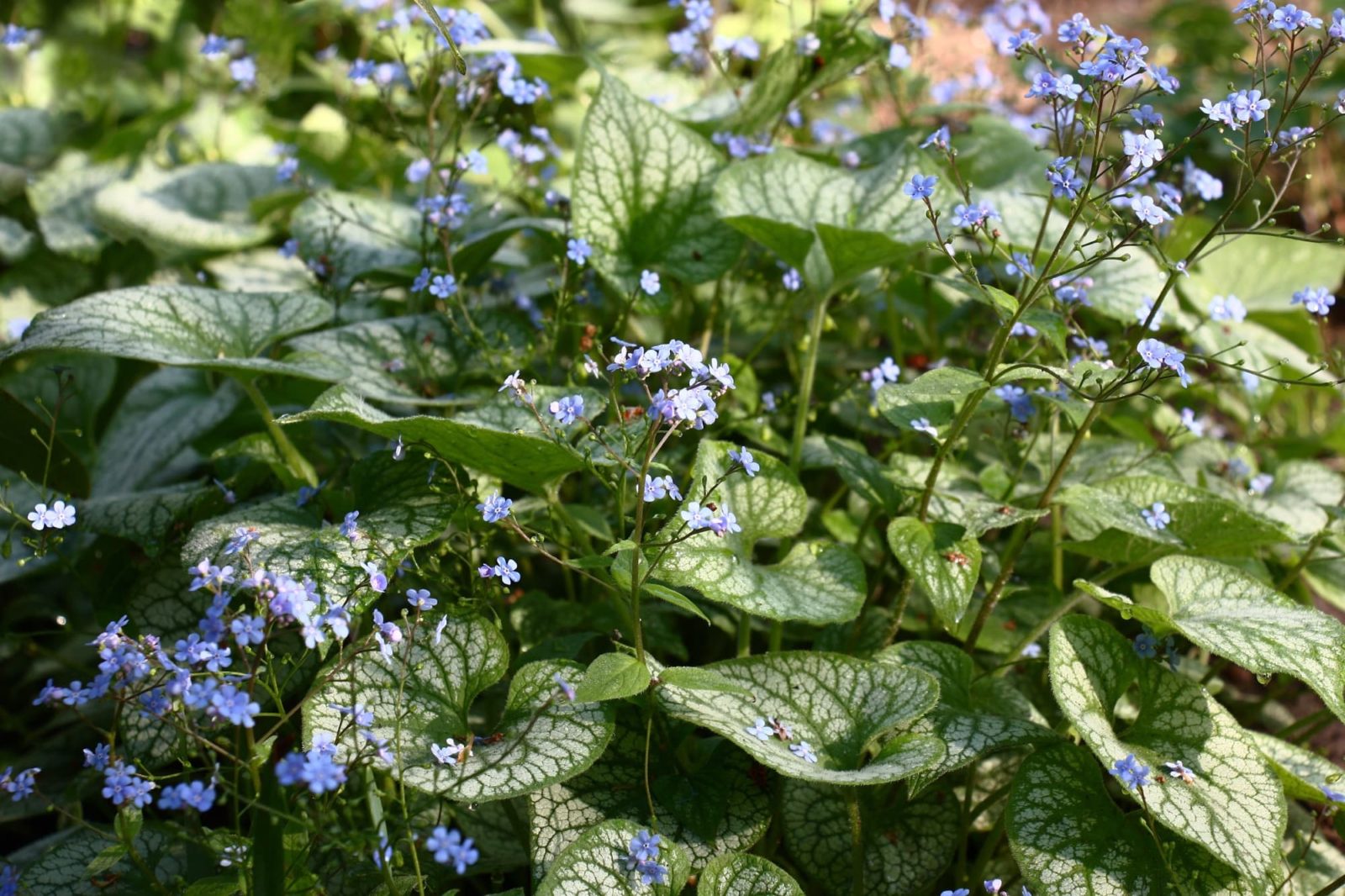PERENNIALS > BRUNNERA

Elizabeth is a Permaculture Garden Designer, Sustainability Consultant and Professional Writer, working as an advocate for positive change. She graduated from the University of St. Andrews with an MA in English and Philosophy and obtained a Diploma in Applied Permaculture Design from the Permaculture Association.
Reviewed By COLIN SKELLY

Colin is a Horticulturist and Horticultural Consultant with experience in a range of practical and managerial roles across heritage, commercial and public horticulture. He holds the Royal Horticultural Society’s Master of Horticulture award and has a particular interest in horticultural ecology and naturalistic planting for habitat and climate resilience.
Contributions From PIPPA CHAPMAN

Pippa is a Forest Gardener and Permaculture Designer from Keighley in West Yorkshire. She is a published author with her book 'The Plant Lover's Backyard Forest Garden' available online. Pippa trained with the RHS and the Permaculture Association - and has spent time as Head Gardener of a large private estate.
IN THIS GUIDE
BRUNNERA GUIDES
Brunnera macrophylla, also known by many as ‘Siberian Bugloss’, is a commonly grown garden plant in the UK.
Though not native to our shores, it is well-suited to a shaded or partially shaded spot and will generally be untroubled by slugs or snails, unlike hostas and other plants for shade.
Brunnera macrophylla is native to woodland ecosystems of the Caucuses and Türkiye.1Brunnera macrophylla (Adams). (n.d.). Kew Botanic Gardens. Retrieved June 6, 2023, from https://powo.science.kew.org/taxon/urn:lsid:ipni.org:names:113714-1
It is the best known of a number of species within the Brunnera genus and is certainly the most commonly grown option here in the UK.
Particularly prized as ground cover plants for dappled, partial or even deeper shade, many cultivars of this species of Brunnera have been developed, with some prized as foliage plants rather than for their flowers because of their variegated leaves.
Overview
| Botanical Name | Brunnera macrophylla |
| Common Name(s) | Siberian bugloss |
| Plant Type | Perennial |
| Native Area | Caucuses and Türkiye |
| Hardiness Rating | H6 |
| Foliage | Deciduous |
| Flowers | Small sprays of bright blue |
| When To Plant | May to September |
Sunlight
Preferred
Partial Shade or Full Shade
Exposure
Sheltered
Size
Height
0.1 – 0.5M
Spread
0.1 – 0.5M
Bloom Time
April to May
Soil
Preferred
Most fertile soils
Moisture
Moist but well-drained
pH
Any
Their flowers, while small, are also delightful.
A great choice for woodland or forest gardens, Brunnera not only creates good ground cover but also attracts pollinators in the spring, around the same time that these are required for fruit tree pollination.
Common Varieties
There are numerous varieties of Brunnera that you might grow.
One of the ways to narrow down your choices is to look at the Brunnera which have been given an Award of Garden Merit from the RHS:
B. macrophylla ‘Hadspen Cream’
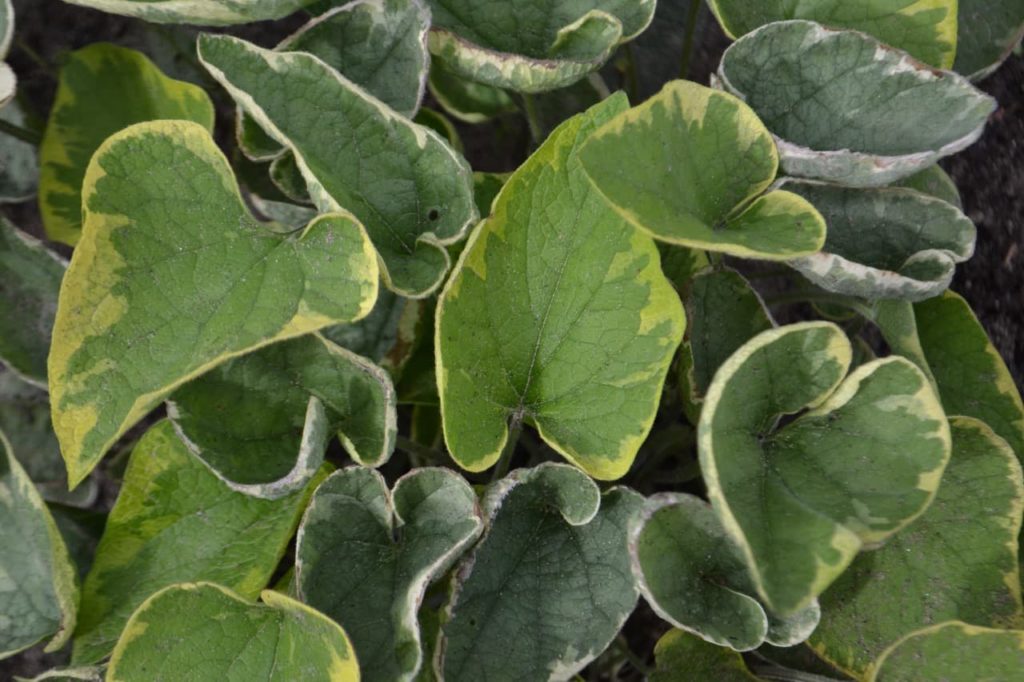
Has blue flowers and green leaves that are margined with cream.
B. macrophylla ‘Jack Frost’

Known for its silvery green-veined leaves with a frosty appearance.
B. macrophylla ‘Looking Glass’

Has silvery foliage with sparse veining in green.
B. macrophylla ‘Mister Morse’
Also has silvery leaves but has white flowers too.
Planting Brunnera
Brunnera can be planted any time from May to September, but planting in late spring or early autumn is ideal.
When choosing where to plant them, it is important to think about the amount of sunlight an area receives.
Brunnera can cope in the sun as long as the soil has enough moisture, but it will generally do best in dappled, partial or full shade.

You can grow Brunnera in the ground in a suitable spot or in a container.
When planting, whether in the ground or in a container, the plant should sit at the same level that it was at in its previous pot so that the top of the root system is level with the surface of the growing medium.
Firm the soil or growing medium around the new plant and water it in well.
Water frequently until the plant becomes well-established.
Soil Requirements
Brunnera needs moist but free-draining soil or any reasonably fertile peat-free growing medium when grown in a container.
These plants do need consistent moisture but, other than this, are not particularly fussy about the soil or medium in which they grow.
Growing From Seed
Brunnera is not usually a plant that home-growers will cultivate from seed, as most cultivars are purchased as potted plants.
“Seed collected from cultivars will often not be true to the parent plant, meaning that most cultivars are best purchased as plants that have been propagated clones,” explains Horticultural Consultant Colin Skelly.
“Some cultivars can tend to revert to the species, Brunnera macrophylla, and should be dug up and the reverted sections removed so that this portion does not end up engulfing the usually less vigorous cultivar.”
To propagate a Brunnera that you already grow in your garden, root cuttings can be taken in the winter months.
Alternatively, plants can simply be lifted and divided in the early spring.

However, if you would like to grow Brunnera from seed, it is possible to do so.
Often, they will self-seed in ideal conditions, but to take things into your own hands, mix some seeds into a moist potting mix and then place this mix in a plastic bag and pop it in the freezer.
Cold stratify the seeds for around 4 weeks.
After this, the seed should be sown at temperatures of 16°C and should germinate within 1-3 months.
However, germination rates may still be patchy.
Brunnera Plant Care
Once you have Brunnera growing in your garden, you should find it to be a remarkably easy, trouble-free and low-maintenance addition to your space.
Watering
Brunnera should, as mentioned above, be well-watered as it becomes established.
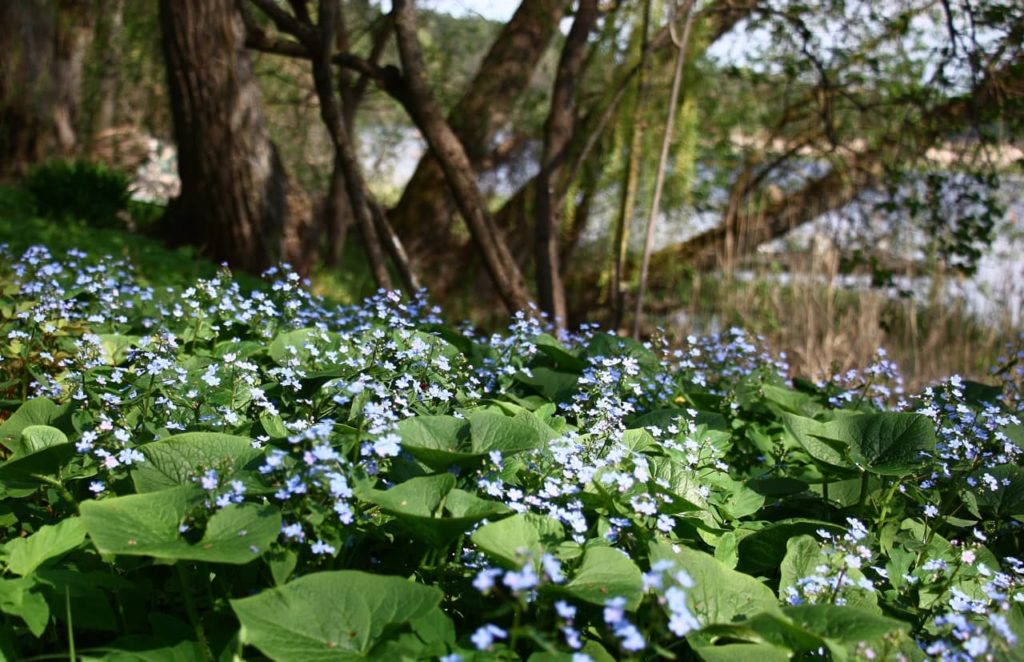
In many cases, natural rainfall should often be sufficient once the plant has established and you won’t need to think about watering much, if at all.
Pruning
No pruning is required when growing Brunnera, but you can cut off any brown leaves and deadhead when the autumn arrives if you wish to do so.
Dividing
While pruning is not necessary, clumps can become overgrown or congested over time, so it is best practice to lift and divide mature Brunnera plants every 3 years or so.
Of course, this is also how you will most easily be able to obtain new plants to place elsewhere in your garden.
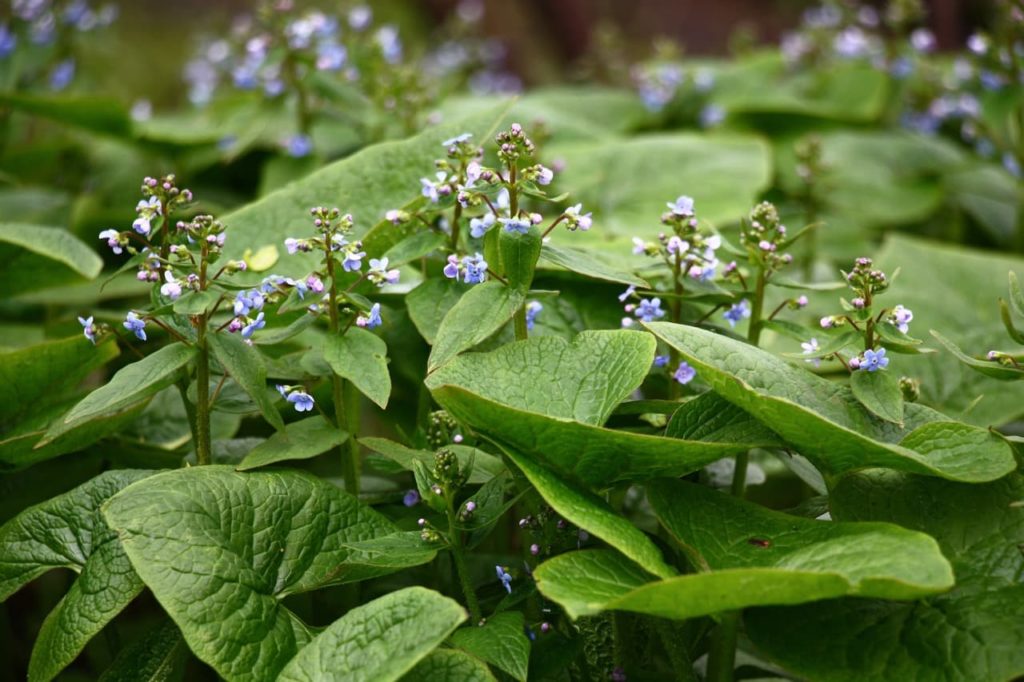
To divide a Brunnera plant, simply lift it using a garden fork.
Divide it with your hands or with a spade, before separating and replanting the sections you have created.
Make sure that each section or division has roots and you should be able to create a whole bunch of new plants.
Common Problems
Brunneras don’t tend to have many serious problems and what problems they do have tend to be related to improper placement or care.
As long as your plants are in fertile soil that is moist yet free-draining and are not getting too much sun, you should generally find that no great problems arise.
Brunnera is notably slug resistant most of the time and it is generally not eaten by browsing animals due to the texture of the leaves.
However, Brunnera can still be eaten by pests every once in a while.
It is not uncommon to see some leaf damage caused by nematodes, slugs or rabbits if you have these creatures in your garden.
FAQs
Can You Grow Brunnera Indoors?
Though not typically grown as a houseplant, it is certainly possible to grow Brunnera indoors.
The lower light levels indoors are not generally a challenge to these shade-loving plants.
However, it is important to make sure that you water enough to keep the growing medium moist (though not waterlogged) at all times.
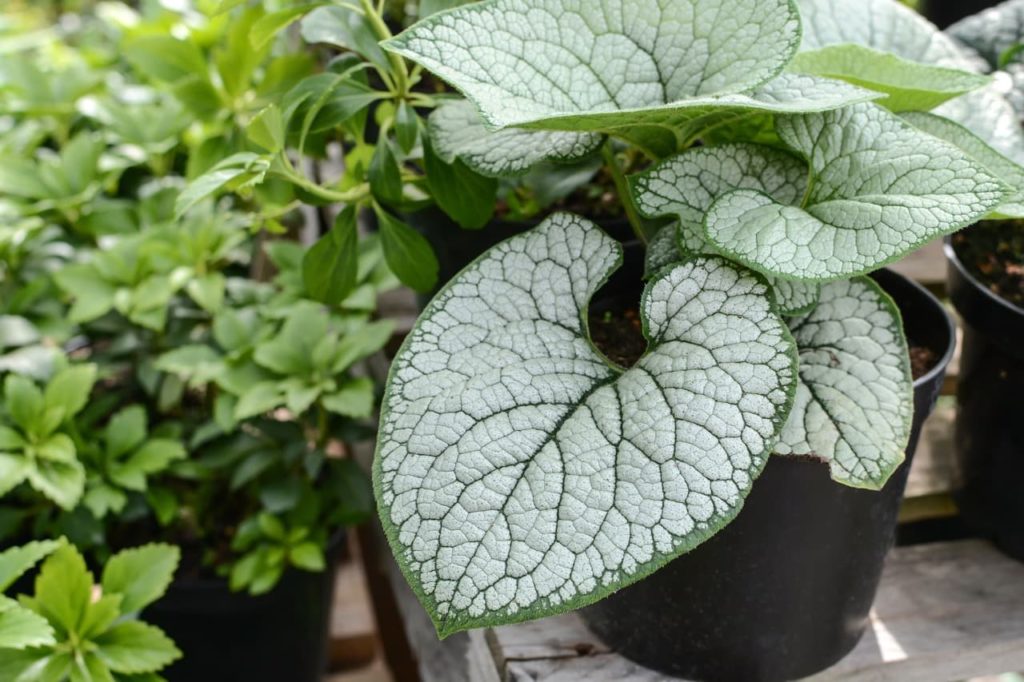
You will also need to keep the plant in a reasonably cool room in your home and ideally not a centrally heated space, which will get too warm and dry.
Remember, this is a herbaceous perennial that will die back over the winter months before bursting into new growth in the spring.
While it is dormant, the plant should be placed in a garage, shed or other similar location before bringing it back indoors in the late winter or early spring.
Is This An Invasive Plant?
Brunnera makes good ground cover as it can spread relatively quickly.
“Brunnera ‘Alexander’s Great’ is a particularly vigorous, large-leaved cultivar that is ideal for use as ground cover,” adds Colin.
This means that where the conditions are ideal, it can have a tendency to take over and may be considered invasive, in the sense that it will outcompete other plants.
However, if you lift and divide Brunnera clumps when they are mature, you should not find that these are plants that will get out of control and you should be able to keep them in check.
In some areas, they will self-seed where conditions are moist enough, but this is usually of benefit and not a problem in most UK gardens.
Why Are My Brunnera Leaves Turning Brown?
The leaves of a Brunnera plant turning brown is typically a sign of plant stress.
Usually, there is an issue with the environmental conditions that cause the leaves on the plant to die and potentially drop off.

Brown leaves on Brunnera are most commonly caused by:
- Dry conditions or underwatering
- Sunburn (when in too sunny a location)
- Pests (causing brown patches)
Of these three, the first two are the most common, so most of the time, the problem will be easy to address by moving the plant to a more suitable location and making sure that you water more frequently, especially if you are growing your Brunnera in a pot.
References
- 1Brunnera macrophylla (Adams). (n.d.). Kew Botanic Gardens. Retrieved June 6, 2023, from https://powo.science.kew.org/taxon/urn:lsid:ipni.org:names:113714-1

